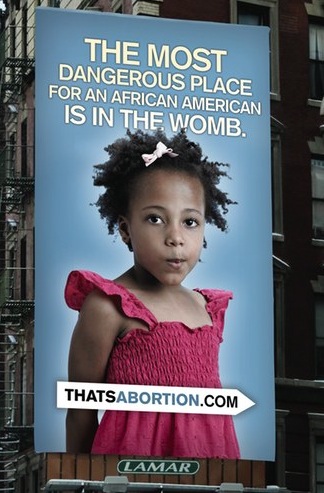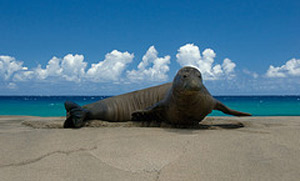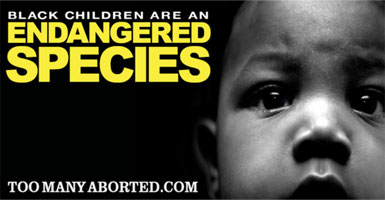
On Tuesday, New Jersey mother Trisha Fraser announced she’s suing anti-choice groups that used images of her 6-year-old daughter for a race-baiting ad campaign. “The most dangerous place for an African American is in the womb” proclaimed billboards in New York and Florida that featured a then-4-year-old Anissa Fraser. Controversy over the ad erupted late last year when a billboard first went up near Manhattan’s high-traffic Holland Tunnel. The ad was by the Holland Tunnel for four months before it was taken down following complaints by city officials, Al Sharpton, and Trisha Fraser. But in February 2011, the billboard went up again, this time near a busy intersection in Jacksonville, Florida.
The ad with the the larger-than-life photo of Fraser was paid for by Majella Cares aka Heroic Media and its affiliate Life Always, both Texas organizations dedicated to discouraging reproductive freedom. The agencies use large ads to drive site traffic and spread their message, like many other organizations do. But it’s the content of the ad that’s making it so controversial. “I would never endorse something like that,” Fraser told the Associated Press. “Especially with my child’s image.” Fraser’s lawsuit against both companies claims that her daughter’s picture was used for “defamatory, unauthorized, and offensive” purposes.
The picture of Fraser’s daughter seen on the billboards comes from ImageSource, a stock image broker, and its parent company, Getty Images. To purchase stock photos from Getty Images, advertisers like Heroic Media are required to sign an agreement stating the photos won’t be used “in connection with a subject that would be unflattering or unduly controversial to a reasonable person.” The agreement also says the images can’t be used in a defamatory way. If the image is used for something controversial, like anti-choice messages directed toward black women, advertisers are required to get clearance from the model or indicate somewhere on the billboard that the model is not affiliated with the message. According to Fraser’s complaint, this didn’t happen.
“The billboard was defamatory of Anissa and/or her mother in that it gave the false suggestion, impression, and implication that they approved of the racist and offensive message contained therein,” reads Fraser’s claim. Fraser’s lawyer Andrew Celli says “the issue isn’t [Life Always and Heroic Media’s] position on abortion. It’s the statement that children of color are at risk because African-American women are exercising their right. That’s the racist part, that African American women are dangerous to their children.”
Fraser’s complaint says Anissa has booked fewer modeling jobs as a result of her image being associated with the campaign. Fraser was also forced to discuss reproductive choice issues with her six-year-old daughter to explain the attention she received from the media and people who know her family. Mother Jones contacted Life Always, a group led by tea party darling and FOX Nation commentator Stephen Broden. Here’s a portion of its statement:
Life Always did not violate its contractual obligations but rather properly exercised its constitutional rights to engage in free speech on a matter of significant public interest. Life Always will continue placing advertisements across the country to educate and raise public awareness of confrontational truths about abortion. The billboard, which read, “The most dangerous place for an African American is in the womb,” was erected to draw attention to the New York City Health and Mental Services statistics report that in 2009, 60% of African American babies in New York City never made it out of the womb.
For the record, about 47 percent (not 60 percent) of black women in New York City reported abortions in 2009. Mother Jones has covered the “abortion equals black genocide” debate before. At its core, the rhetoric is less about care for black people’s well-being, and more about controlling all women’s reproductive choices, regardless of race.















